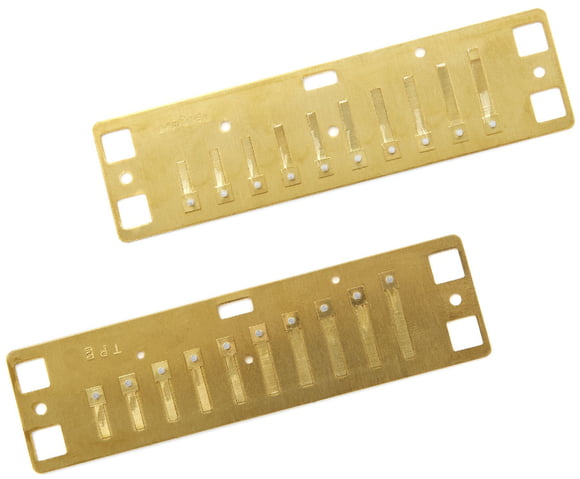4. How Harmonicas Work
There are actually several different types of harmonica, and they each need a slightly different playing method. However, they share the same basic structure. Two plates holding the reeds - the reed plates - are attached to the upper and lower surfaces of a comb, made of wood, metal or plastic. This assembly is then enclosed by cover plates, which allow the player to hold the instrument without touching the reeds. They also help to amplify the sound. Chromatic harmonicas also have a slide, which the player uses to select the additional notes.
The Comb
Combs can have single channels, double channels, or even two-way channels which allow you to play on either side of the harmonica. The different materials used to make the comb affect the sound and playability of the instrument. Plastic combs give a consistent tone and have the advantage that they are less affected by moisture and temperature. Wood gives a richer, organic sound, while metal, or metal plated combs make for brighter, clearer tones.
The Reed Plates
These are usually made of brass, though nickel and chromium plated plates are also sometimes used. Again, the material used helps to define the quality of the tones produced. The reeds themselves are usually made of the same material as the plates, and are secured by rivets. They fit snugly into the slots cut into the reed plates, so that no air can escape when theyre not being played. In chromatic harmonicas, valves are also used to close the non-playing channels, because there are extra slots in the reed plates.

Richter diatonic reed plates
The Cover Plates
Most cover plates are made of sheet metal. They protect the reed plates and reeds and give the player something to hold. Since the sound of the harmonica is shaped substantially by the chamber made by the hands, the cover plates make a significant difference to each players tone. They also define the look of the harmonica. Most manufacturers engrave their cover plates in their own unique style, and the designs vary from model to model.
Tuning
Most harmonicas employ the same basic tuning pattern, following the diatonic scale - doh, re, mi, fah, so, la, te, doh. This is why the standard blues harp, such as the Marine Band, is known as a diatonic harmonica. Even a chromatic harp is essentially two diatonic harps in one, with one tuned a semitone higher than the other.
Of all the different types of harmonica, the Richter model has become something of a standard, mainly because its tuning configuration makes it so versatile. The Marine Band, reckoned to be the worlds best-selling harmonica, is a Richter harmonica.
A simple scale on a Richter diatonic harmonica, tuned to the key of C, can be played by blowing and drawing from the fourth hole:
| Blow notes: | C E G C |
| Draw notes: | D F A B |
But if you play a scale from the first hole, the pattern is as follows:
| Blow notes: | C E G C |
| Draw notes: | D G B |
There is no F or A note. This is known as the Richter tuning, and it is used to make it easier to play harmonies, or chords. A full C chord and G chord can be played when blowing and drawing in the lower holes. It means that you must learn to bend notes when playing in the lower register of the harmonica - and it means that you can reach some soulfully wailing blues notes as well.



